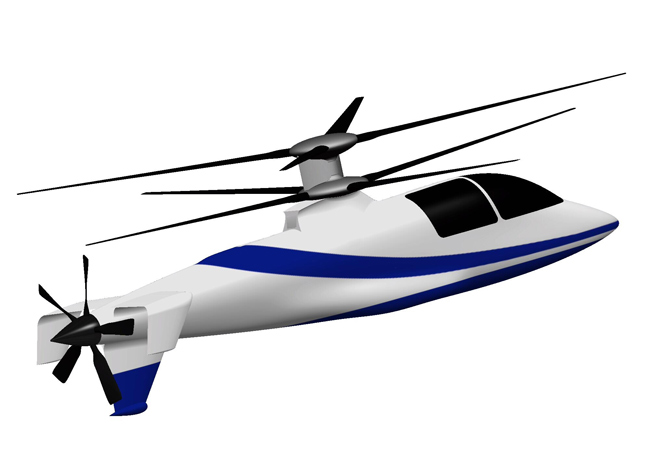Sikorsky's X2: Developing a Faster Helicopter

Nearlythree years ago, Sikorsky Aircraft announced it would develop technologies ? collectivelycalled "X2 Technology" ?that would significantly change helicopter flight. Every day thousands ofpeople in the United States travelin helicopters, among them politicians, executives, tourists and patients.
The mainadvantage of helicopters? categorized as rotary-wing aircraft ? is their ability to take off and land vertically.However, compared with fixed-wing aircraft, they are slow. For example, the12-passenger S-76 helicopter flies at 178 mph, but an 11-seat BeechcraftKingAir 350 turboprop flies at 350 mph, nearly twice as fast.
However, UnitedTechnologies Corp. subsidiary Sikorsky Aircraft, the oldest name in helicoptermanufacturing, is working to change that by developing a helicopter that willfly almost as fast as a conventional aircraft ? without using the mechanicallycomplex and expensive tilt-rotorsystem pioneered by Bell.
Sikorskyplans a faster helicopter
On June 6,2005, Sikorsky announced that it would build and test a technology demonstratorthat would maneuver like a conventional helicopter and cruise at 250 knots (288mph), which is at least 60 percent faster than conventional helicopters.
X2Technology helicopters will affect passenger travel due to substantiallyreduced flight times. For example, flights between Bridgeport, Conn. and JFK Airport in New York City would be decreased from 40 minutes to 25 minutes.Also, X2 Technology medevachelicopters would be able to transport people in critical condition tohospitals in significantly less time, potentially saving lives.
?Weinitiated X2 Technology convinced that the most productive and flexiblehelicopter is a helicopter which is capable of a significant increase in speed,?said Stephen Finger, then-president of Sikorsky Aircraft. ?Customers aredemanding greater speed but without sacrificing any of the unique capabilitiesthat make helicopters theideal platform for countless civil and military missions.?
Get the Space.com Newsletter
Breaking space news, the latest updates on rocket launches, skywatching events and more!
Advancedaerospace technologies
Although thetop speed of helicopters has not increased much since the 1960s, improvementsin computers, materials, navigation systems, and other aspects of aircraftduring the past two generations have been unprecedented.
Sikorsky?sX2 Technology Demonstrator incorporates leading-edge aerospace technologies,including digital fly-by-wire flight controls, counter-rotating rigid rotorblades that spin more slowly as the helicopter reaches higher cruising speeds,active vibration control, an integrated auxiliary propulsion system, and more.
X2Technology aircraft will take-off and land vertically, hover, maneuver at lowspeeds, and transition from hover to forward flight like regular helicopters. However,the new Sikorsky aircraft will have one or more aft-mounted ?pusher? propellers,a significant difference in design from helicopters of the past six decades.
Coaxial,counter-rotating blades
Mosthelicopters have a ?disc? of rotating blades on top of the fuselage and shorterblades mounted on the side of the tail that spin in a plane roughlyperpendicular to the main disc. The purpose of the aft blades is to provide acounterforce to the torque effect on the fuselage created by the spinning maindisc. The X2 Technology Demonstrator has a coaxial rotor system comprised oftwo hubs with blades attached. The hubs spin in opposite directions, whicheliminates the torque effect.
?The X2Technology Demonstrator is an integrated suite of technologies intended toadvance the state-of-the-art, counter-rotating coaxial rotor helicopter. As wecontinue to work to prove and mature the technologies that will allow the X2Technology Demonstrator to become a viable product, we are focused on testingits limits and finding out where this technology will take us," JeffreyPino, Sikorsky?s president, said recently.
?This couldbe a ?game changer? in the industry,? Pino said of the X2 TechnologyDemonstrator at Heli-Expo 2008, the main U.S. helicopter convention. "Weare diligently pursuing this as a research project. We are testing the limitsand pioneering this exciting innovation."
Sikorskybuilt the X2 Technology Demonstrator in collaboration with subsidiary SchweizerAircraft, and funded the project entirely by itself. The aircraft continues tomake progress toward its first flight, said Peter Grant, Sikorsky's senior managerof Advanced Programs.
?Throughout2007, the aircraft made excellent additional build and subsystem test progress,re-entering vehicle ground testing in November 2007,? said Grant. "Extensivetest instrumentation is also being installed as preparation for its firstflight."
Nofirst-flight date yet
Groundtesting of the X2 Technology Demonstrator is still underway and Sikorsky hasn'tyet scheduled a date for the aircraft's first flight, said company spokesmanPaul Jackson.
"Experimentalaircraft have minds of their own ? sometimes you have to let them proceed attheir own pace," said Jackson. "For that reason, we have not targetedany date for the first flight."
SikorskyAircraft, has been consulting with helicopter operators to determine how X2Technology aircraft would benefit their business at a price they can afford. Sikorskyis developing plans to design and build a civilian X2 Technology helicopterthat would satisfy operators? requirements and appeal to the traveling public.
"Certainlycivilian travel appears to be a promising market. People will be able to flyback and forth from visits, dates, and meetings twice as fast each way as itnow takes by helicopter," said Jackson. "Perhaps a helicopter airtaxi market will evolve as many aviation experts have predicted for thesmall-airplane segment."
Join our Space Forums to keep talking space on the latest missions, night sky and more! And if you have a news tip, correction or comment, let us know at: community@space.com.









